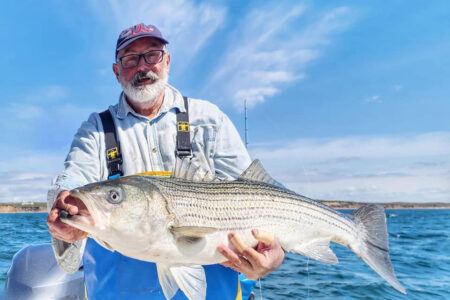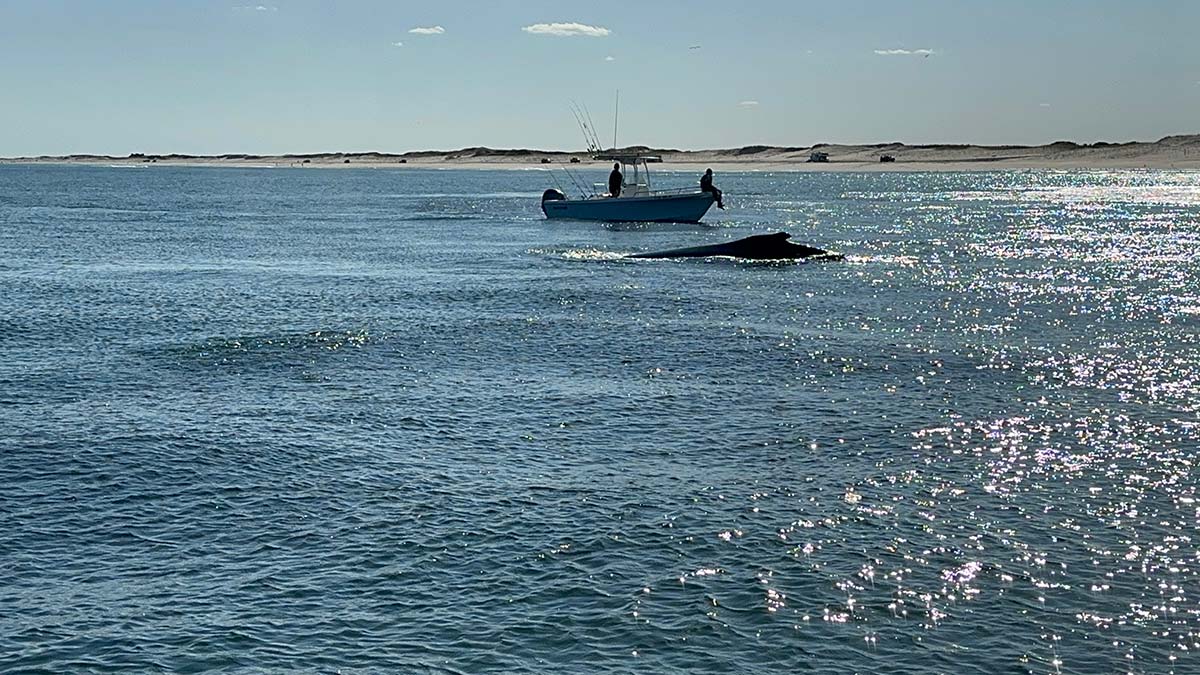
Bunker schools arrived along the Jersey Shore in March, but it’s show time in April!
The main thrust of the striped bass migration hits the Jersey coast from April to June, and then again from October until December. Of course, this is a generality and little wiggles in the timing of their appearance take place many-a-year. Nonetheless, understanding when to set aside other tactics and employ the livelining tactic will enhance your fishing experiences for years to come.
Menhaden are a schooling fish that filter feed on phytoplankton and zooplankton. They can live as long as 12 years and top out at about a pound. They are commonly referred to as bunker or pogies. Juvenile and adult menhaden are a major forage food for most gamefish in addition to birds of prey, whales and dolphins. They swim tight the beach and commonly traverse mid shore waters out to 20 miles or so. Bays, rivers, creeks and basins are additional congregating points where pogies swirl. A typical striped bass consumes hundreds of pounds of bunker on its migration up and down the east coast. Menhaden are an essential source of food that stripers must have in order to live long and healthy lives.
Anglers that find large bunker schools and pods when striped bass are migrating through the area have an increased chance at finding good liveline action. Bunker schools are present during spring, summer and fall in most places, but that doesn’t mean there’s bass on the bait all the time. Often the key is understanding when the striper migration moves through your local waters. If you aren’t one to prospect and try to hit the first wave of bass, which often holds some of the largest cows, word will often leak out in a few days to a week that the bunker bite is, in fact, on!
I recently caught up with a couple of Central Jersey striped bass captains to get their thoughts on this particular fishery. Capt. Greg Cudnik operates both Fish Head Charters and Fisherman’s Headquarters on Long Beach Island; his family having taken over the shop in 1984, Greg grew up in the fishing business and is an expert on striped bass patterns. Just to the north, Capt. Alex Lebkes runs On Point Charters out of Point Pleasant and is a young, hard-charging skipper who’s making a name for himself on the striper scene.
“In the early morning, I usually pass up on the first few bait pods (outside the inlet) because then I’ll get run over by each and every boat in the parade,” Cudnik said when I asked how he chooses where to start when the bass are in his home waters. “I run to find some space and then hunt, utilizing my Garmin. I’m visually looking for bass pushing water or bunker acting unusual,” he said.
“I’m also looking at my screen for bass readings and I can identify which pods of bait have striped bass present and which ones don’t fairly quick,” said Cudnik, adding “This past fall when dogfish invaded it was paramount to know the difference in striper marks and doggy marks on the screen.”
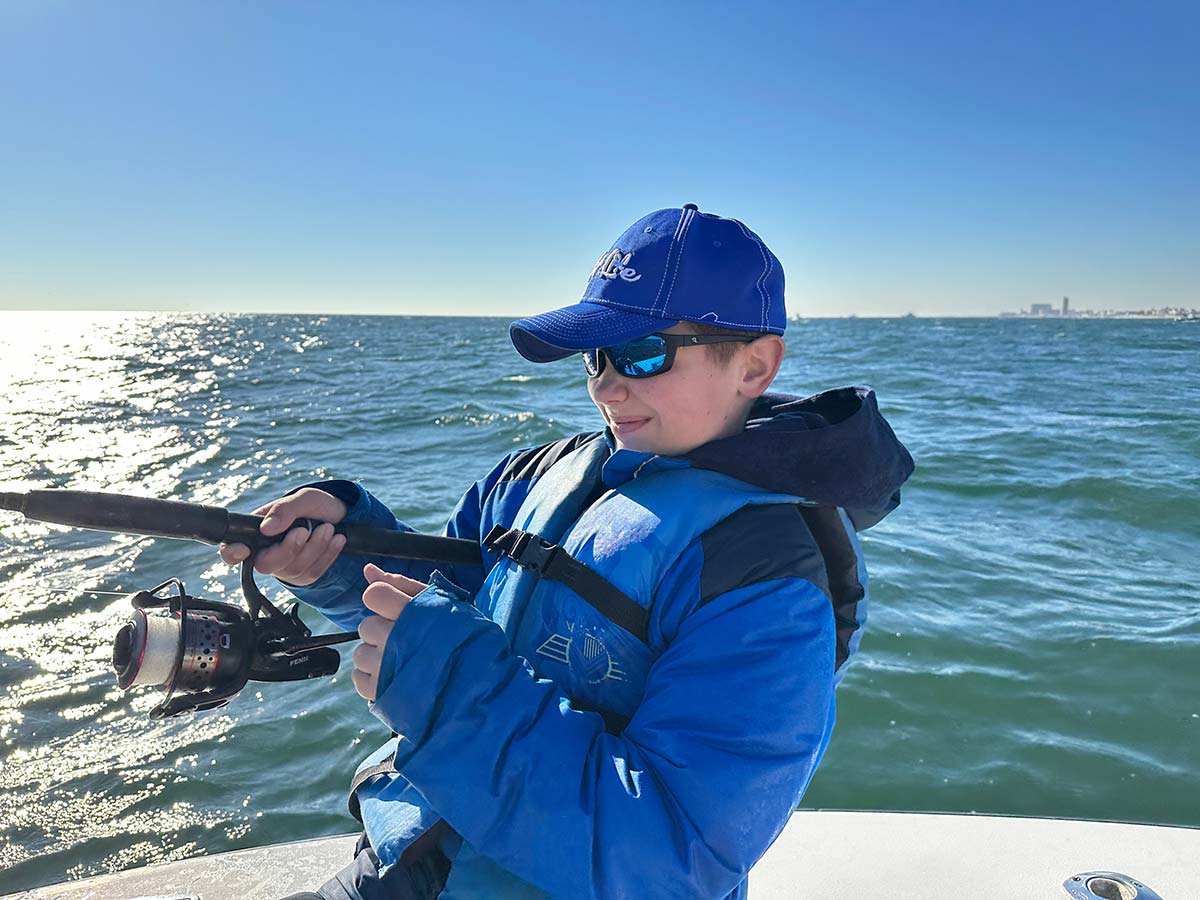
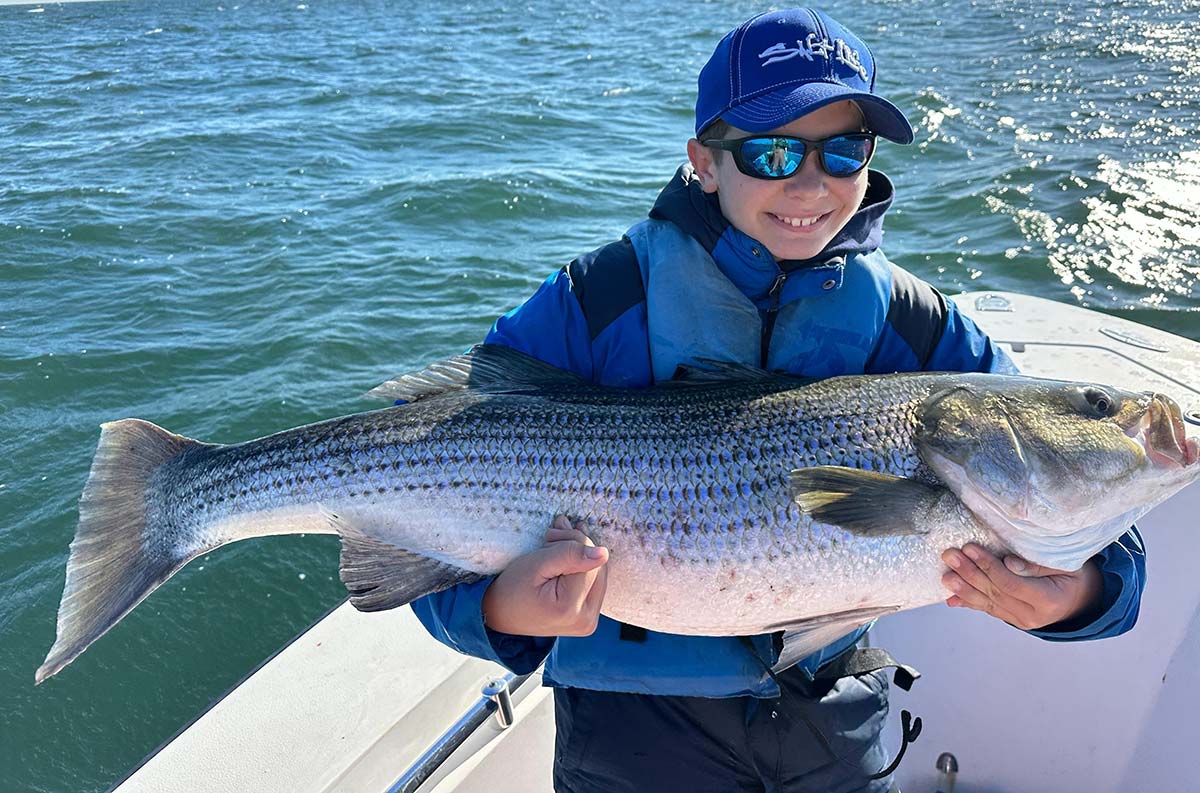
Even Better Days Ahead?
Indeed, this past fall was one of the best autumn bunker bites in years as giant striped bass were feeding within a mile of the beach on a daily basis when fishing waters north of Island Beach State Park. Even when the bass pushed offshore, they stayed mostly inside the three-mile line with both bunker and bass still feeding off South Jersey well into December when most boats were already hauled out for the winter.
Departing from Manasquan allows Lebkes to fish some of the best waters for livelining in the Garden State. “I look for dark patches on the water or the raining effect on the surface,” he said. “I try not to stop on a pod without much commotion. However, that can change when boat traffic is heavy as sometimes it’s better to stop on a pod that’s been passed by other boats to catch a fish or two then move to the next and do the same.”
When bait is showering and bass are rolling, it’s an easy decision to deploy bunker or toss plugs. It’s when no visual signs present themselves that captains have to use their learned knowledge and prior experiences to find fish. Reiterating what the On Point captain said, stripers can be present and harassing schools of menhaden without announcing their presence. Angler awareness and keen instincts can help determine where to fish. A high-quality sounder can assist in marking fish on the screen and within the bunker schools.
When talking about what wind direction is best, there’s no hesitation from either captain. “West is the best,” they both proclaimed. In fact, any offshore wind will help drive the bunker inshore and hopefully bring the bass with them. In New Jersey, west and northwest winds rank at the top as offshore winds go; chilly north winds are solid; however, east and northeast winds aren’t always conducive to pushing fish toward the surf. Of course, that doesn’t mean don’t hunt bunker. The schools will likely push further off the beach and since those winds bring seas, it might require spotting dark-colored schools under the surface or using the bottom machine to detect menhaden.
On those choppier days, I prefer to zig zag from a half-mile off the beach out to the deeper water columns, eyes peeled looking for bunker, birds or whales feeding. Whales are a great indicator of bunker schools and the bass will feed in the same waters and close to the mammals. Conversely, I’ve never had equal luck fishing bunker schools near dolphins and have found their presence to be less than optimal.
Living On The Edge
Upon finding a promising school of bunker, deciding where to fish can be pivotal. “I almost always fish the edges and the upwind side and drift through,” Cudnik said, adding “The edges are where the bass are corralling.”
Captain Lebkes also likes to work the lead edge. “We usually move in front of the bunker for several reasons,” Lebkes said, explaining “Bunker move into the wind and the front edge of the school is usually the most active with bass.” After the action diminishes, experienced and mindful captains will motor back to the front contour of the bunker and begin the process again, but they’ll give the bait a wide berth in order to maintain the natural feeding process. Boats that motor through an active pod only shorten the life of the bite and irritate the neighboring anglers.
Sometimes bass feed away from the densest schools of menhaden. Case in point, there are occasions where continuing to fish in the lee of a passing bunker school is highly productive. Stripers, while aggressive on bait clusters, are also adept scavengers. It’s not laziness, rather intelligence that provokes large, cow bass to hang back thus picking off bunker separated from the heard due to injury or ill-fate. Capt. Cudnik told me there are other times that he will pick up and move with a livewell full of baits. “I’ll take my bunker to structure, shoals or the inlet where I know there are bass,” he said, adding “I’ll also fish deeper waters out to the three-mile line where trolling boats traditionally fish.”
Often the liveline bite lulls mid to late morning. Bunker can be taken to the deep where there are often less menhaden schools balled up; however, actual schools of bass can be marked on the screen. Captains use the marks as bullseyes to send out bait. These instances fly in the face of the “bass are always with the bait” philosophy as stripers are willing to travel just offshore of the thickest bunker schools imaginable when it suits them.
I asked each captain what they’d advise in the event an angler is fishing a pod where other boats are getting bit, but not theirs; all anglers can attest to having been in this most frustrating scenario. “I first make sure the baits are in the right position in addition to looking for bass readings more on the port or starboard,” Cudnik said. “Are the lines being fished on the (boat) side with the better bass marks? Are the baits lively and thumping or are they tired in which event I always swap out with new baits,” he continued. “But while swapping, I always make sure there is at least one bait in the water still.” Aggressive bait management is certain to help increase strikes.
Lebkes subscribes to the old realtor mantra – location, location, location. “I would start by moving the boat to a different side of the pod and then make sure my circle hook rigs were right,” he said. “Maybe add weight.” Before snag and drop with a weighted treble became off-limits, some of the best action came with an ounce of weight at the hook. Thus, what Lebkes is saying is consistent with what has worked for decades. To achieve weight at the circle hook, anglers can place a one-ounce egg sinker above circle hook or they can run a three-way rig similar to those used for fluke, the weight in the form of a bank sinker.
Another way to provoke a bass strike is to “goose” the hooked bunker so all those around it flee momentarily, hence leaving the bait alone and exposed. This works well on the largest schools where the bait seems outnumbered a million to one. Other anglers change where the bait is hooked. Instead of the nose, baits can be hooked in the back or the tail area which creates different swimming action. And finally, some fishermen send a cut bunker to the bottom. This works great as long as a dogfish or skate don’t find it first.
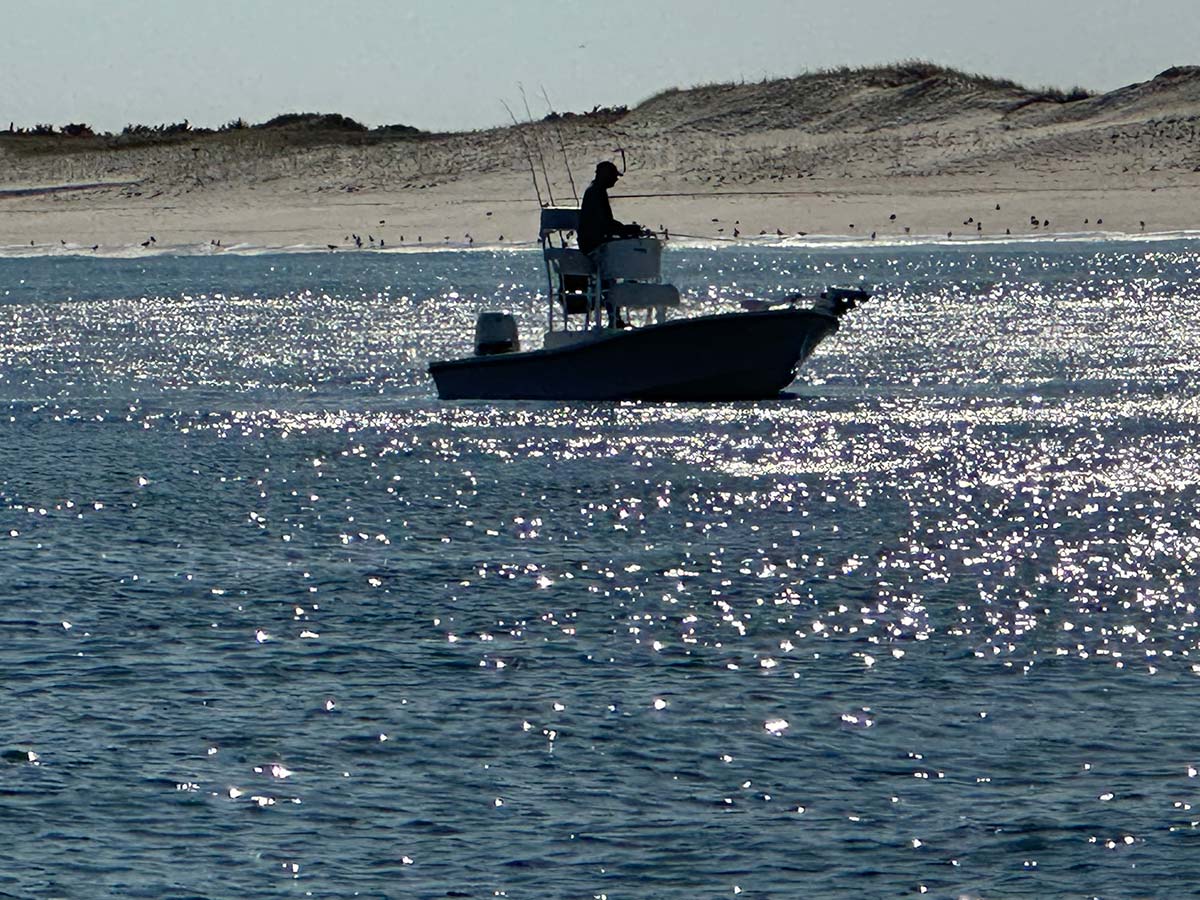
All Geared Up
So yes, the snag and drop method is done. Ever since the Atlantic States Marine Fisheries Commission issued a coastwide requirement that all anglers targeting striped bass with natural baits like bunker must use non-offset circle hooks, the practice of snagging and fishing live baits with a weighted treble became illegal. While you can still snag bunker to put in the livewell off the Jersey Coast, both Cudnik and Lebkes readily say cast-netting is the best bet.
Both captains like reels with modern features. Capt. Cudnik prefers the PENN Spinfisher VI 4500 reels because the Live Liner function allows bass to grasp and turn with the bait without being detected. Lebkes likes the Shimano Baitrunner version which provides the same functionality. Thirty-pound test braid is the norm. I’m a huge fan of Berkley X9 or Spiderwire Durabraid, though Cudnik has an affinity for 30-pound Cortland Master Braid.
Medium to medium/heavy class rods with enough back bone to cast a hooked bunker or finish off a 50-pound bass at the boat are best. I’ve used some light rods and they will work, but there is risk of potentially playing the fish wrong with undersized tackle. The PENN Battalion series is my favorite for livelining.
Cudnik feels strongly about the hook at the business end of his 50-pound leader. “I like the Mustad 39951 wide gap inline circle hook,” he said. “It’s a medium/light wire hook with a straight eye that I’ve found to offer me a really good hook up ratio. I tend to stay away from octopus circles and the last two years I went down in hook size significantly. I’m fishing live bunker, hooked in the nose, with 6/0 and 7/0 size hooks,” he stated.
The reason? “I found that the larger hooks would allow for the bait to move around on the bend and shank (of the hook).” The 10/0 octopus circles are probably the most popular hooks for livelining in the current era of mandated circle hooks, and they certainly catch, but Cudnik’s experimentation has merit and is worth a try.


